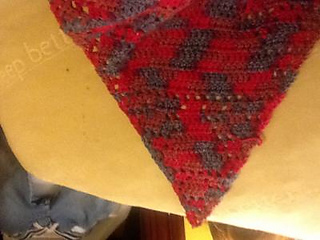patterns >  marypat.org
marypat.org
> Crochet Sierpinski Fractal Triangle


Crochet Sierpinski Fractal Triangle
This can be any size yarn or hook -- the technique creates a fractal triangle pattern as can be seen here:
http://en.wikipedia.org/wiki/Sierpinski_triangle
The important thing is to pick a yarn/hook combination such that the pattern is well-defined.
I’m currently using a worsted weight cotton with an F hook, but I’ve also used more bulky yarns with an N hook -- one could do this in thread with a very small hook.
I’ve used this pattern to make a shawl, a wall-hanging, and a trivet.
This pattern is a procedure, where you look at your prior row as you work to decide what to do next via a specific rule. This technique is called a cellular automaton. There are other rules you can try once you get a hang of this pattern.
I will give the first few rows, and then give the rule -- because you can always add another row using the rule, this is a potentially infinite pattern (got a huge stash you want to use up for a monster size project? Use this pattern!)
So here’s the pattern: ch = chain ch-sp = chain space dc = double
crochet (the american definition)
Row 1: Ch 4. 2 dc in 1st ch - 1st row, counts as 3 dc. (the turning chain is 3 ch, and counts as one dc). Ch 3, turn.
Row 2: 1 dc in 1st dc, Ch 1 & skip middle dc, 2 dc in last dc. (so looks like - 2 dc, ch-sp, 2 dc) Ch 3, turn.
Row 3: 1 dc in 1st dc, Ch1 & skip next dc, dc in ch-sp, ch 1 & skip next dc, 2 dc in last dc. (looks like: 2 dc, ch sp, dc, ch sp, 2dc) Ch 3,
turn
The procedure:
A. You’re going to add a dc at each end for each row (that’s the 1 dc in the 1st, + the turning chain at the beginning, and the 2 dc in the last dc); this gives the standard triangular shawl shape. One starts at the tip and works until the triangle is as large as you wish.
B. Now, you’re going to be looking at the previous row while you build up your current row. The rule is to look at the two “areas” neighboring your current area in the previous row. If there’s two spaces, or no spaces, you simply do dc’s straight. If there’s exactly one space , make a ch1-sp, then dc.
To check that you understand how this procedure works, I will demonstrate with the 4th row:
a. First do the turning chain and 1 dc in the 1st dc. (You’ve just added a new “area”)
b. Looking at the previous row, you see a ch-1 sp immediately to the left and two dcs to the right. So looking at my rule - exactly one space, make a space - I ch 1, skip a dc, and dc in the ch-sp in the row below. Second area done.
c. Now, I look below, and I see a ch-sp to the left, and a ch-sp in the right. My rule: two spaces beget no spaces, so I do 1 dc each in the next two dcs. Third area done.
d. Finally, I see the ch-sp to the right, and 2dcs to the left, so exactly 1 sp. So I ch-1, skip the dc and dc in the next (and last dc). Fourth area done.
e. Finally, one more dc in the final dc, to add an area on the end.
So the pattern of the 4th row: 2 dc, ch-sp, 3dc, ch-sp, 2dc.
I will give the next couple rows so you can check that you understand the rule. Actually try this out without looking and then compare.
5th row: 2 dc, ch-sp, 1dc, ch-sp, 1dc, ch-sp, 1 dc, ch-sp, 2 dc.
6th row: 2dc, ch-sp, 7dc, ch-sp, 2dc
If you do this correctly, on every row there should be 1 ch-sp at the very beginning and 1 ch-sp at the very end. Some of the rows will have nothing but dcs and no spaces. Some rows will be completely full of ch-1, 1dc blocks.
If you screw up the rule, you won’t get the perfect Sierpinski fractal, however, if you make a single mistake and keep applying the rule, what will happen is you will get an irregular fractal result, which can be pretty cool.
- First published: March 2002
- Page created: January 29, 2014
- Last updated: January 29, 2014 …
- visits in the last 24 hours
- visitors right now

